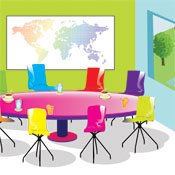Many people think the only thing is takes to change the world is fire in the belly and a lot of action. Not so fast. Building a sustainable community takes good conversation and planning that lead to best practices and enduring smart actions. And the design of your meeting space can make a difference in whether your goals are met.
Peter Block, a partner of the Ohio-based Designed Learning, gives tips to designing an effective physical space in his book "Community: The Structure of Belonging" (Berrett-Koehler Publishers, 2008, $26.95). "Change the room, change the culture," he advises. His tips for designing or arranging communal space where people can relax and talk include:
Take the control out of meeting rooms. Use round, or at least oval, tables where everyone can see each other, and no one is at the "head" of the table.
Meet in rooms with windows, a view, green plants and inspiring art on the walls.
Amplify the sound, if needed, so everyone can be heard equally.
Choose swivel chairs with low backs so people can move easily.
Avoid auditoriums for community conversations; save them for one-way presentations and performances.
Make reception, hallways and waiting areas comfortable and inviting by adding chairs and even internal windows into the offices that line them.
Don't use a stage or platform to isolate any participants in a civic dialogue.
Always include a form of art at community meetings (visual, music, poetry, dance, writing).
Break bread at every gathering. Display and share healthy, locally grown and prepared food and drink. "It brings the sacred into the room," Block says of including delicious food in your meetings.
More like this story
More stories by this author
- EDITOR'S NOTE: 19 Years of Love, Hope, Miss S, Dr. S and Never, Ever Giving Up
- EDITOR'S NOTE: Systemic Racism Created Jackson’s Violence; More Policing Cannot Stop It
- Rest in Peace, Ronni Mott: Your Journalism Saved Lives. This I Know.
- EDITOR'S NOTE: Rest Well, Gov. Winter. We Will Keep Your Fire Burning.
- EDITOR'S NOTE: Truth and Journalism on the Front Lines of COVID-19



Comments
Use the comment form below to begin a discussion about this content.